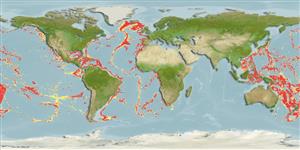>
Ophidiiformes (Cusk eels) >
Ophidiidae (Cusk-eels) > Neobythitinae
Etymology: Xyelacyba: Greek, xyele, -es = plane (tool) + Greek, kybeia, -ou = a fish (Ref. 45335).
More on author: Cohen.
Environment: milieu / climate zone / depth range / distribution range
Ekologi
laut batidemersal; kisaran kedalaman 984 - 2500 m (Ref. 34024). Deep-water
Possibly worldwide in tropical and subtropical seas (but not yet caught in the eastern Pacific) (Ref. 34024). Eastern Atlantic: 2 specimens between 12°N and 9°25'N. Western Atlantic: Gulf of Mexico to off southern Brazil. Northwest Pacific: Ashizuri Cape, Japan.
Size / Weight / umur
Maturity: Lm ? range ? - ? cm
Max length : 57.0 cm TL jantan/; (Ref. 3686)
duri punggung lunak (Keseluruhan (total)): 89; Sirip dubur lunak: 74. Body and tail strongly compressed, snout round and short, no spine on tip. Head and body uniformly whitish, margins of median fins light brown, jaws, pelvic fins, mouth and gill cavities deep brown. Peritoneum and stomach deep brown, intestine yellowish.
A benthopelagic species at bathyal depth (Ref. 56809). Found on the continental slope (Ref. 75154). Rare species (Ref. 34024). Reproductive strategy possibly similar to other members of this family featuring oviparity, with oval pelagic eggs floating in a gelatinous mass (Ref. 205).
Nielsen, J.G., D.M. Cohen, D.F. Markle and C.R. Robins, 1999. Ophidiiform fishes of the world (Order Ophidiiformes). An annotated and illustrated catalogue of pearlfishes, cusk-eels, brotulas and other ophidiiform fishes known to date. FAO Fish. Synop. 125(18):178p. Rome: FAO. (Ref. 34024)
Status IUCN Red List (Ref. 130435)
ancaman kepada manusia
Harmless
penggunaan manusia
Perikanan: tidak ada kepentingan
informasi lanjut
Umur / SaizPertumbuhanpanjang-beratpanjang-panjangukuran frekuensiMorfometrikMorfologiLarvaDinamika larvapemulihanKelimpahanBRUVS
AcuanBudidaya airprofil budidaya airStrainGenetikaElectrophoresesDiturunkanPenyakit-penyakitPengolahanNutrientsMass conversion
mitraGambarStamps, Coins Misc.Suara-suaraCiguateraKecepatanTipe renangArea insangOtolithsOtakPenglihatan / visi
Alat, peralatan
laporan khas
muat turun XML
Sumber internet
Estimates based on models
Preferred temperature (Ref.
123201): 2.5 - 5.2, mean 3.5 °C (based on 1299 cells).
Phylogenetic diversity index (Ref.
82804): PD
50 = 1.0000 [Uniqueness, from 0.5 = low to 2.0 = high].
Bayesian length-weight: a=0.01122 (0.00514 - 0.02450), b=3.04 (2.87 - 3.21), in cm total length, based on all LWR estimates for this body shape (Ref.
93245).
Trophic level (Ref.
69278): 3.7 ±0.6 se; based on size and trophs of closest relatives
Daya lenting (Ref.
120179): sedang, Waktu penggandaan populasi minimum 1.4 - 4.4 tahun (Preliminary K or Fecundity.).
Fishing Vulnerability (Ref.
59153): Moderate vulnerability (43 of 100).
